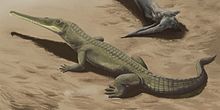Crurotarsans
| Crurotarsans Temporal range: Early Triassic–Present, 250–0 Ma |
|
|---|---|
 |
|
| Life restoration of Protome batalaria | |
 |
|
| Life restoration of Ornithosuchus woodwardi | |
| Scientific classification | |
| Kingdom: | Animalia |
| Phylum: | Chordata |
| Class: | Reptilia |
| Clade: | Archosauriformes |
| Clade: |
Crurotarsi Sereno & Arcucci, 1990 |
| Subgroups | |
Crurotarsi is a group of archosauriform reptiles that includes the archosaurs (represented today by birds and crocodilians) and the extinct, crocodile-like phytosaurs. The name is derived from the Latin word crus and the Greek word tarsos; it refers to the specialized articulation between crus and tarsus—specifically between fibula and calcaneum—present in the skeletons of suchians and phytosaurs, with a hemicylindrical condyle on the calcaneum articulating against fibula.
The name Crurotarsi was erected as a node-based clade by Paul Sereno and A. B. Arcucci in 1990 to supplant the old term Pseudosuchia, but with a different definition. Crurotarsi includes, by most published definitions, all descendants of the common ancestor of modern crocodiles, ornithosuchids, aetosaurs, and phytosaurs; Nesbitt (2011) provided a shorter definition, defining Crurotarsi as "the least inclusive clade containing Rutiodon carolinensis Emmons, 1856, and Crocodylus niloticus Laurenti, 1768". According to two studies published in 2011 by Nesbitt and coworkers, using either of these definitions leads to the inclusion of all other true archosaurs in Crurotarsi, due to the possibly basal phylogenetic position of the phytosaurs. This means that grouping the phytosaurs and crocodilians into a clade while excluding the avemetatarsalians (pterosaurs, dinosaurs, and birds) would result in a paraphyletic grouping. A more definitive group is Pseudosuchia, which is defined as all archosaurs closer to crocodiles than to birds (matching the traditional content of Crurotarsi).
...
Wikipedia
